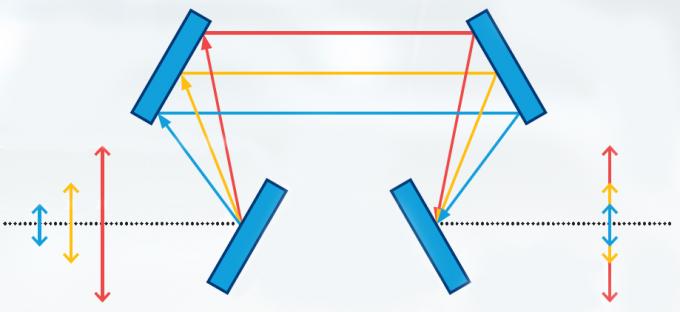For more than two decades, Lawrence Livermore's high-energy, ultrashort-pulse lasers have been expanding scientists’ knowledge of the behavior of matter under extreme conditions. One enabling technology for generating ultrashort laser pulses with very high intensity uses a method called chirped pulse amplification (CPA). A signal is said to be “chirped” when the frequency increases or decreases with time.
CPA laser systems first stretch out in time a short pulse of low-intensity light, converting it into a lower-intensity, longer-duration (thousands of times longer) pulse that can be amplified without damaging costly laser optics. After this step, shorter (blue) wavelengths of higher frequencies lag behind the longer (red) wavelengths of lower frequencies of the light pulse.
In the final stage of the CPA laser, the pulse is compressed in time by a set of diffraction gratings, in which the shorter wavelengths “catch up” with the longer wavelengths to achieve a cohesive, short-duration, very-high-intensity laser pulse that is focused on a target.
A diffraction grating is an optical component that separates incoming light into its constituent wavelengths. The reflection angle depends on the wavelength and the spacing between the very fine lines inscribed in the grating’s metallic substrate (typical spacing is approximately 1 micrometer). Both the stretcher and compressor normally consist of four diffraction gratings. By careful geometric arrangement of the four gratings, different frequencies of laser light can be made to travel different distances through the device, thus modifying the duration of a laser pulse.
Livermore’s dominance in the growing field of high-energy, short-pulse lasers will be further aided by Computing’s capability to simulate the physical processes of lasers and their interaction with matter. With Laboratory Directed Research and Development funding, a team of Computing scientists, led by Anders Petersson and joined by National Ignition Facility postdoctoral researcher Sam Schrauth, is advancing that simulation expertise.
The team is developing a first-principles simulation method to model the interaction of laser light with diffraction gratings, and to determine how grating imperfections can affect the performance of the compressor in a CPA laser system. Their code is called GEFIE-QUAD for gratings electric field integral equation on quadrilateral grids. The code will give scientists for the first time a powerful simulation tool to predict the performance of a realistic laser compressor.
Despite advanced manufacturing techniques utilized by Livermore and industry, gratings may possess minute imperfections that can result in imperfect diffraction, which in turn yields an imperfect alignment of all wavelengths in time. Such timing errors can produce various unwanted effects, including a small pre-pulse of laser light that essentially “leaks” enough intensity before the main pulse arrives to compromise the experiment.
“We don’t fully understand what type of grating aberrations are disturbing the laser beam uniformity,” says Petersson. “So we have to work from first principles to be able to accurately simulate the spatial and temporal effects introduced by grating imperfections.”
When the code is complete in about a year, scientists will use GEFIE-QUAD to model geometric imperfections of realistic gratings and determine for the first time how these imperfections affect the performance of a CPA system.
Simulating realistic laser compressors is computationally challenging, Petersson says, because of the necessity to solve the full set of Maxwell’s equations (governing the propagation of laser light) and the large range of length scales, ranging from the wavelength and line spacing of about 1 micrometer to the laser beam diameter of about 0.1 meter. The problem is intractable in the three-dimensional space and time domain because it would require an enormous number of grid points and time steps to propagate a light pulse through a compressor.
Instead, the team is solving the problem in the frequency domain and representing the electric field by currents along the grating surface. The variation of the surface currents over a grating is calculated by an iterative method, which is accelerated by the fast multipole algorithm to reduce the computational complexity. The convergence of the iterative method is improved by using a preconditioner based on the Calderon identities. An additional advantage of working in the frequency domain is that different frequencies in the pulse can be modeled independently—a task well suited for massively parallel simulations on distributed memory supercomputers available at Livermore, including Vulcan, Quartz, and Sierra.
Petersson is confident GEFIE-QUAD will help Livermore retain its leadership in short-pulse lasers as well as strengthen Computing’s core competencies in advanced mathematical and high performance computing techniques. He is hopeful the effort will foster greater collaboration between laser researchers and Computing’s simulation experts.



